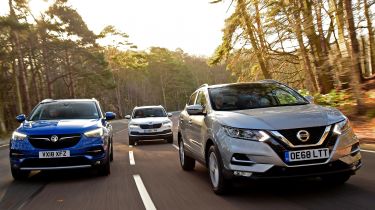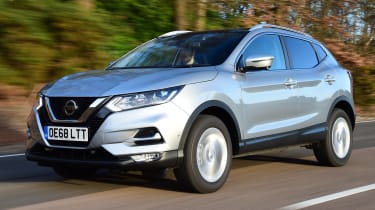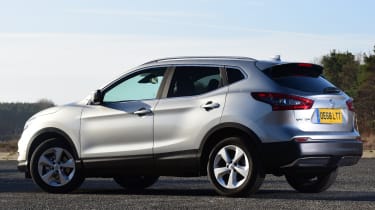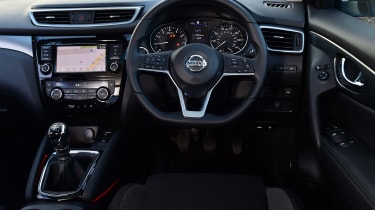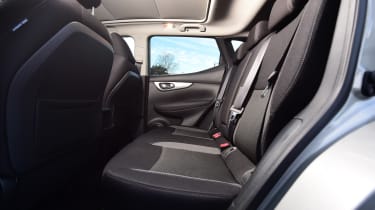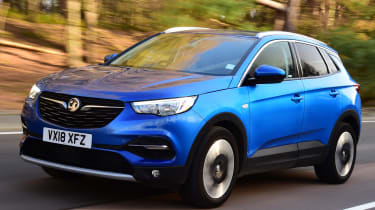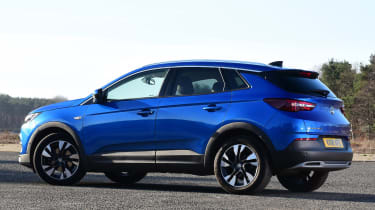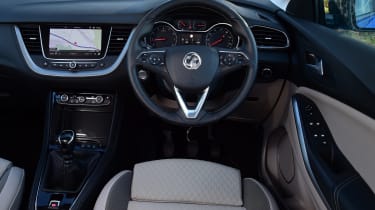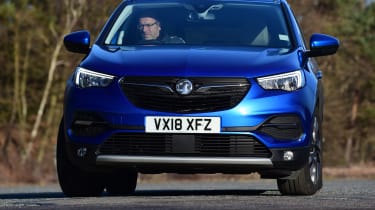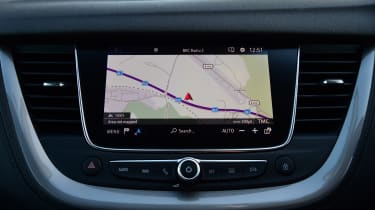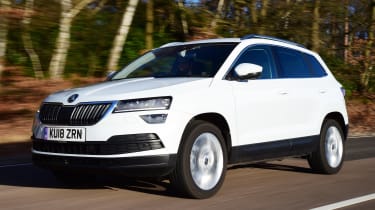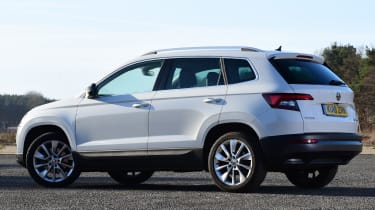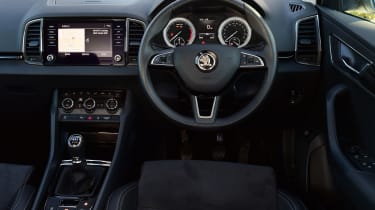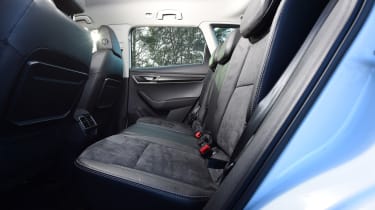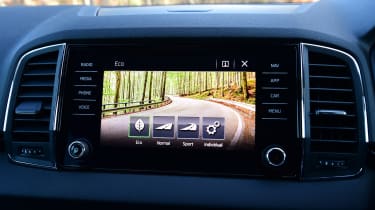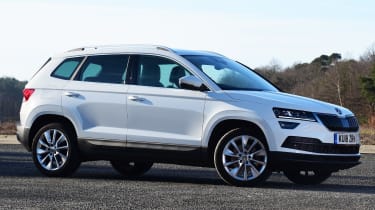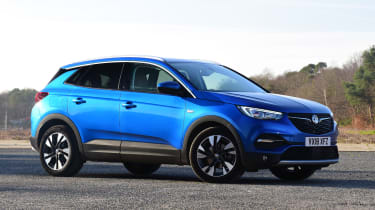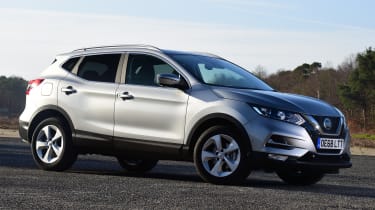Nissan Qashqai vs Vauxhall Grandland X vs Skoda Karoq
Can the punchy new engine help Nissan's Qashqai regain its place at the top of the crossover pile as it faces Vauxhall and Skoda?
The original Nissan Qashqai might not have been the first crossover, but it captured the essence of a movement in the motor industry at a perfect time, delivering SUV looks on a hatchback budget. It’s no surprise, then, that the Mk1 model and the updated Mk2 version, which moved the game on successfully, took the accolade of Auto Express’s car of the past 30 years last summer when we celebrated our special milestone.
Despite a facelift in 2017, the Qashqai has lagged behind newer opponents, which have gained ground. And as the market moves back towards petrol that has become especially true, because the Qashqai’s older, downsized turbocharged offerings were lacklustre. To be competitive in this class you need a strong, punchy but frugal engine, which is why Nissan is hoping that this new 1.3 DIG-T 140 unit will right the wrongs of its petrol predecessor.
To test its credentials, we’re pitting the Qashqai with this fresh engine against its toughest rivals in the shape of the Vauxhall Grandland X and our current favourite, the Skoda Karoq.
Both petrol SUVs pack a punch and mix it with the efficiency and usability that family buyers crave. So can the Nissan shape up thanks to some new tech under the bonnet? Read on to find out.
Nissan Qashqai
| Model: | Nissan Qashqai 1.3 GIG-T 140 N-Connecta |
| Price: | £24,595 |
| Engine: | 1.3-litre 4cyl turbo, 138bhp |
| 0-60mph: | 9.0 seconds |
| Test economy: | 38.0mpg/8.4mpl |
| CO2: | 121g/km |
| Annual road tax: | £140 |
The pre-facelift Mk2 Nissan Qashqai was a solid Auto Express favourite, so the crossover sits on a firm foundation. But is the updated engine enough to elevate it towards the top of its class? We test the £24,595 1.3 DIG-T 140 N-Connecta to find out.
Design & engineering
This new 1.3-litre turbocharged four-cylinder engine is big news. It’s sourced from Mercedes (where it’s fitted to the A-Class hatch) and stems from the Renault-Nissan Alliance’s commercial tie-up with that brand’s parent company, Daimler. The unit produces 138bhp and 240Nm of torque – competitive figures compared with many of its crossover rivals that occupy this space. It’s more refined than the version in the Mercedes hatch, too, as we’ll see.
Used - available now

2016 Nissan
Qashqai
16,012 milesManualPetrol1.2L
Cash £12,500
2022 Nissan
Qashqai
12,256 milesManualPetrol1.3L
Cash £17,800
2018 Nissan
Qashqai
36,176 milesAutomaticPetrol1.3L
Cash £15,500
2017 Nissan
Qashqai
48,556 milesAutomaticPetrol1.2L
Cash £12,500The engine sends power to the front wheels through a six-speed manual gearbox, while the Qashqai’s chassis set-up is the same as the facelifted car’s, based on the Alliance’s CMF-C/D platform and using strut-type front suspension and a torsion-beam back axle. There’s no improvement to the packaging.
Nor is anything different inside. N-Connecta trim is well equipped and treads the line nicely between cost and kit. Sat-nav, Apple CarPlay and Android Auto are fitted, as is some extra safety tech including blind spot assist, autonomous braking, parking sensors and a rear camera, climate and cruise control.
There aren’t many complaints here; the issue we have is how the features are integrated into the cabin and the quality of the finish. In a class that’s still growing incredibly rapidly, with more and more models launching, the Nissan’s low-rent plastics and dated design aren’t as appealing as the Vauxhall’s interior, let alone the Skoda’s superior cabin.
While the Qashqai is relatively well priced, at £24,595, splitting its two rivals here and offering a similar level of tech, it doesn’t feel as nice. PCP deals also mean list price isn’t the be all and end all.
Driving
The engine is a big improvement over the old 1.2 DIG-T, though. It feels much more gutsy, revs more smoothly and is relatively refined.
As our track tests show, the motor is a willing performer and delivers decent pace. The Qashqai outsprinted the Grandland X from 0-60mph, taking 9.0 seconds to the Vauxhall’s 9.6 seconds, while it also had the edge in gear. It was around a second faster between 30 and 50mph in fourth, as well as from 50 to 70mph in fifth and sixth.
This level of flexibility is welcome, because the light, springy clutch action and imprecise gearshift detract from the powertrain’s other merits. The box still isn’t the nicest, and although it’s fit for purpose, the Karoq has a much more rewarding and reassuring action even if you’re not a keen driver.
Similarly, the ride is hampered by traits Nissan’s engineers haven’t managed to iron out. The front suspension is soft and ensures there’s enough travel and a relatively loose feel to the damping. While this means bumps are absorbed acceptably, it can sometimes cause a nodding motion at the front – the symptoms are often highlighted by having to add more steering in a corner, just when you think it’s set right.
The rear suspension still bounces aggressively in response to ridges that run transversely across the road. The faster you go the more noticeable this is, as the rear suspension struggles to contain the energy involved. It creates an obvious imbalance between front and back that means the Qashqai’s chassis never quite settles down at speed, eroding comfort and the engine’s new-found refinement.
Still, this isn’t a driver’s car, but both the Vauxhall and Skoda combine more rewarding set-ups with greater levels of comfort and refinement as well.
Practicality
Packaging and practicality highlight the Qashqai’s older underpinnings. Boot capacity is 430 litres with the rear seats in place, which is some way behind the Grandland X’s 514 litres and the Skoda’s flexible offering of between 479 litres and 588 litres depending on the seating configuration.
There’s enough room in the rear – especially for a family car where children will most often sit in the back – but it’s still not as roomy as either competitor.
Nor is the driving position as comfortable, even if visibility is good. At least getting in is easy, so if you have young children that you might be strapping in, the raised ride height will save contorting your back.
Ownership
Nissan finished strongest of these brands in our Driver Power 2018 satisfaction survey, taking fourth place in the makers’ chart. Owners also voted the second-generation Qashqai the 22nd best car to live with.
Safety kit was updated in the 2017 facelift and N-Connecta spec features six airbags, autonomous braking and blind spot assist. Some of the tech available optionally elsewhere isn’t offered on this trim level, yet it still has a five-star Euro NCAP rating.
Running costs
If you’re a cash buyer our experts predict the Nissan will lose the most money over three years/36,000 miles, despite updates including this new engine.
The Qashqai is expected to shed £13,569 (a residual value of 44.8 per cent), while the Vauxhall drops by £11,888, which equates to a residual value of 49.2 per cent. The Skoda bucks depreciation the best, with an estimated residual value of 50.9 per cent. Even though it’s the most expensive car to buy, it’s set to lose £12,599 and thus be worth the most, at £13,061.
Testers' notes
“The engine is the same unit as the 1.3-litre turbo petrol found in Mercedes’ A-Class hatch. It delivers less power here (although there’s also a DIG-T 160 available), but is more refined in the Qashqai.”
Vauxhall Grandland X
| Model: | Vauxhall Grandland X 1.2 Turbo Tech Line Nav |
| Price: | £23,410 |
| Engine: | 1.2-litre 3cyl turbo, 128bhp |
| 0-60mph: | 9.6 seconds |
| Test economy: | 38.9mpg/8.6mpl |
| CO2: | 121g/km |
| Annual road tax: | £140 |
Vauxhall gained a head start with its Grandland X SUV – we’ll see why in a moment – but this Tech Line Nav model (our pictures show a Sport Nav) fitted with the 1.2 Turbo 130 petrol engine has lots going for it – not least the price, at £23,410. The question is whether it’s enough to beat the Qashqai?
Design & engineering
That head start came from Peugeot/Citroen’s buyout of Vauxhall/Opel, giving the British brand access to the PSA Group’s tech. As a result, the Grandland X is based on Peugeot’s EMP2 modular platform that also underpins the French firm’s 3008 SUV. That car is a previous class favourite of ours, which was only knocked off the top spot by the Skoda Karoq, so the underpinnings are a known quantity.
The chassis is on the softer side and set up for comfort, which is what most buyers in this class want. Strut suspension and a torsion-beam back axle are on the menu here to match the Qashqai, while the engine and transmission are taken from the Peugeot line-up and are competitive.
There’s a 1.2-litre three-cylinder turbocharged motor that produces 128bhp and 230Nm of torque. These figures are 10bhp and 10Nm down on the Qashqai’s, while the Grandland X is 50kg heavier, too, but it’s still a punchy unit. That’s helped by the gearing of the six-speed manual transmission.
The interior isn’t quite as funky as the 3008’s, though. Quality is okay – better than in the Qashqai – with a clearer eight-inch touchscreen infotainment system, better plastics and a nicer driving position, with a fresher-feeling cabin. But neither competitor can match the Karoq for quality or ergonomics.
You get a comparable level of equipment to both rivals, though, despite the price advantage. This includes front and rear parking sensors, more safety tech than either the Qashqai or Karoq, cruise control, sat-nav, CarPlay, Android Auto and 18-inch alloys.
Its competitors in this test both have reversing cameras as standard, but that is a £550 option on the Vauxhall. Otherwise the spec is similar; £180 for wireless charging is an affordable extra, too.
Driving
None of these cars is going to be remarkable to drive, so the Grandland X’s focus on comfort at least means that, most of the time, it should be easy to live with. Like the 3008, it mostly floats over roads where the Qashqai lumbers. However, it’s not perfect. The simple suspension layout means bigger bumps still upset the chassis, knocking the car off line.
It’s all too easy to upset the chassis yourself as well, because the light steering takes some getting used to. Turn too aggressively and you’ll feel the Vauxhall roll, but as long as you keep a lid on your enthusiasm and drive to the Grandland X’s strengths then it’s okay.
Another of those advantages is the engine’s torque. Even though the output is down on the Qashqai, it offers enough flexibility. It almost matched the more potent Nissan in the lower gears, while it was consistently around a second slower from 50 to 70mph in fifth and sixth. However, the gearchange is also sweeter and, although it’s not quite as grunty, it is smooth enough and serves up an adequate level of pull. The box’s shift action still can’t rival the Skoda’s, though, and the car’s chassis also isn’t as composed at higher speeds. At least it’s refined.
This is one of the real areas of separation between the Nissan and Vauxhall, along with the Grandland X’s less bouncy nature over bumps and ruts.
Practicality
It also shades the Qashqai for boot space with the seats up, offering 514 litres. Fold the rear bench and there’s 1,652 litres, which is a similarly large advantage over the Nissan in its maximum configuration, at 1,598 litres. But both are beaten by the 1,810-litre Skoda.
You can tell that the Vauxhall is a next-generation SUV compared with the Nissan, because it’s roomier in the front, with a cabin layout that’s better thought out, while there’s more space in the rear. It’s not night and day, but this advantage will make it a more flexible and easier car to live with, especially with children.
Storage is fine, but another area where the Vauxhall scores marks for practicality over the Nissan is with its infotainment.
Ownership
The Grandland X’s extra safety tech includes lane-keep assist and blind spot monitoring as standard, while autonomous braking, collision warning and six airbags feature as well, as part of a safety pack. This means the Vauxhall gained a full five-star Euro NCAP safety rating, with strong scores across the board.
The brand’s performance in our Driver Power 2018 poll was less impressive, though, with Vauxhall coming 22nd out of 26 brands in the makers’ chart.
While the Grandland X didn’t feature in our list of the best cars to live with, the 3008 topped the table. Much of the Vauxhall’s mechanical make-up is based on the Peugeot, so it should prove just as rewarding.
Running costs
Not only is the Vauxhall cheaper to buy than its rivals, but it should also cost less to run. That list price dictates what you’ll pay in company car tax, so because it’s cheaper than the Nissan but emits the same 121g/km of CO2, putting both in the 25 per cent Benefit in Kind tax bracket, lower-rate taxpayers will pay £1,160 to run the Grandland X – £59 less per year than for the Qashqai.
The Skoda emits more CO2, at 124g/km, but it’s still in the 25 per cent BiK band. Its higher list price makes the Karoq more expensive as a company car, at £1,272 a year, but it’s worth this extra outlay given its talent.
Testers’ notes
“There’s no four-wheel drive here; instead, rough-road progress is aided by a £200 off-road pack that includes a clever ESP adjustment program, called IntelliGrip. There are snow, mud and sand modes.”
Skoda Karoq
| Model: | Skoda Karoq 1.5 TSI 150 SE L |
| Price: | £25,660 |
| Engine: | 1.5-litre 4cyl turbo, 148bhp |
| 0-60mph: | 9.2 seconds |
| Test economy: | 38.9mpg/8.6mpl |
| CO2: | 124g/km |
| Annual road tax: | £140 |
The Skoda Karoq is our favourite family SUV, so is the car the Qashqai needs to overcome. And the Nissan’s chances are better than ever, with a new engine to match up to the Skoda’s 1.5 TSI 150 – which costs from £25,660 in SE L trim. Let’s see how it fares.
Design & engineering
The Karoq is yet another car to be spun off Skoda owner the VW Group’s MQB platform. As with the Qashqai’s CMF-C/D architecture and the Grandland X’s EMP2 underpinnings, MQB is scalable to allow for flexibility in models, with many different engines and transmissions able to slot in to broaden your choice. It’s the way cars are going.
The motor is a 148bhp 1.5-litre four-cylinder turbo petrol, which boasts 10bhp more than the Nissan’s and 20bhp over the Vauxhall’s. It also has the most torque, at 250Nm, and although it’s a bit heavier, at 1,373kg, the car should still be a strong performer.
Suspension layout is common to many MQB-based cars and matches its rivals here with MacPherson struts at the front and a torsion beam at the rear – although Skoda does offer four-wheel drive and those Karoqs get a multi-link back axle. Adaptive dampers are £1,000; these aren’t available on the other cars, but are a pricey extra that’s not essential.
The Skoda is a more expensive car than its rivals, too – £2,250 pricier than the Vauxhall and £1,065 more than the Nissan. However, you can feel where this extra cash goes once you’re inside. The cabin quality is easily the best here. The materials are softer and the design is more interesting, but you don’t lose out when it comes to ergonomics, either.
Equipment is also great. Skoda’s eight-inch infotainment system has sat-nav, CarPlay and Android Auto, and is the best of the bunch, as we’ll see. You also get parking sensors and a reversing camera, autonomous braking, heated seats, adaptive cruise, keyless operation and LED headlights.
Driving
Despite the Karoq’s stronger power figure, it wasn’t quite as quick from 0-60mph as the Nissan. However, it’s more enjoyable getting there, mainly due to the sweeter clutch action and reassuringly positive but light and easy-to-change gearshift.
It matched the Grandland X’s times from 50 to 70mph in fifth and sixth gears, taking 8.7 and 11.0 seconds respectively, while this was a second behind the Qashqai. However, like the Vauxhall, the Skoda’s performance is close enough to the Nissan’s that this isn’t too much of a disadvantage.
The small deficit in performance is more than offset by the benefits of the Skoda’s ride and handling. Its set-up is undoubtedly firmer than the Nissan’s, because there’s less roll in corners, but despite this, it’s also a more forgiving car no matter where you’re sitting; compared with the Qashqai, which feels harsher in the rear, the Karoq is much better balanced.
The steering is more direct and a sweeter weight, which makes the Skoda a sharper car to drive than its rivals, yet it’s just as comfortable, if not more so.
Refinement is the best of these three models as well. While wind noise in the Grandland X is kept to a minimum, the engine thrums like triples tend to, whereas the Skoda’s four-cylinder unit is more hushed. Both are quieter than the Qashqai’s motor.
Practicality
In SE L trim the Karoq gets flexible rear seating, which means the 60:40-split bench slides to either prioritise load space or passenger room. With the boot at its smallest there’s still 479 litres, which is far better than the Qashqai’s offering. Legroom is brilliant and it’s by far the biggest and most practical model here, with enough space that even tall people won’t feel cramped.
Passenger room obviously drops if you slide the seats forward, but there’s still an adequate level of space that’s on par with the Qashqai. In this set-up the Skoda offers an unparalleled 588-litre boot capacity, making it as big as cars from the class above.
The brand’s usual Simply Clever touches are present, too, so there are practical features such as an umbrella under the passenger seat and an ice scraper in the fuel filler door – small things that make a difference.
Cabin storage is great, making this easily the most practical model of the three crossovers on test.
Ownership
Skoda is a traditionally strong performer in our Driver Power survey, and its 2018 result was no different, even if it trailed Nissan’s placing by two spots, ranking sixth overall. The Czech brand’s dealer network easily surpassed its rivals’ here, though. Skoda nearly matched its performance in this section, coming eighth, while the Nissan and Vauxhall garages finished poorly, in 25th and 21st places respectively. Safety makes it a hat-trick for Skoda. A five-star Euro NCAP rating for the Karoq comes courtesy of seven airbags, autonomous braking, pedestrian detection and adaptive cruise. Upgrading with blind spot monitoring and lane-keep assist costs £860.
Running costs
Our trio all returned strong fuel economy on test, with very little to separate them. The Grandland X and Karoq both recorded 38.9mpg, which means an annual petrol cost (based on 12,000 miles per year) of £1,680. The Qashqai trailed them by 0.9mpg, so you’ll only pay an extra £40 a year. Driving style could see this change slightly, so budget around the same for all three.
Servicing will therefore be a relatively important factor. A £342 pack for two services makes the Skoda a cost-effective option, while the Vauxhall and Nissan will cost £408 and £468 respectively.
Testers’ notes
“New £450 Virtual Cockpit digital dash option further enhances Skoda’s already impressive infotainment system, putting clear ground between the Karoq and its two competitors in this area.”
Verdict
First place: Skoda Karoq
In 1.5 TSI form, the Karoq is still the class leader. Smooth, effortless performance combines with decent efficiency and refinement here. The chassis serves up a similarly appealing blend of suppleness and sportiness for an SUV, while the infotainment system is easily the best in this test and puts clear room between it and its two competitors’ set-ups.
Second place: Vauxhall Grandland X
Thanks to its Peugeot underpinnings, the Grandland X inherits a lot of what makes the French brand’s 3008 such a great SUV. The Vauxhall offers enough performance, practicality, comfort and efficiency, with a strong engine, too. But it doesn’t outdo the Skoda in many of these categories, while the Karoq’s technology and versatility outshine the Grandland’s.
Third place: Nissan Qashqai
The Qashqai’s new engine is undoubtedly an improvement and pushes the car closer to the best models in the class. But it’s still held back by its ride, packaging constraints and poor infotainment system. So while the Nissan has moved closer to rivals and will be cheaper to run and more flexible to live with, it still lacks the spark of the best family SUVs.
